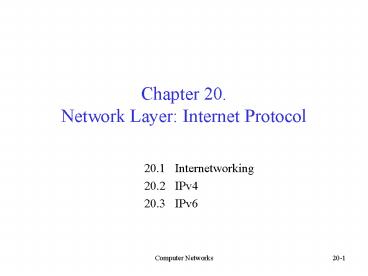Chapter 20' Network Layer: Internet Protocol - PowerPoint PPT Presentation
1 / 26
Title:
Chapter 20' Network Layer: Internet Protocol
Description:
... part: a fixed part and a variable part. Fixed part: 20 bytes long ... Variable part comprises the options that can be a maximum of 40 bytes. Computer Networks ... – PowerPoint PPT presentation
Number of Views:841
Avg rating:3.0/5.0
Title: Chapter 20' Network Layer: Internet Protocol
1
Chapter 20.Network Layer Internet Protocol
- 20.1 Internetworking
- 20.2 IPv4
- 20.3 IPv6
2
Link Layer Interconnection
- Frame in data link layer does not carry any
routing information - Problem How does S1 know that data should be
sent out from interface f3 ?
3
Network Layer in an Internetwork
- Network layer is responsible for host-to-host
delivery and for routing the packets
4
Network Layer
5
Internet Protocol (IP)
- Switching at the network layer in the Internet
uses the datagram approach - Communication at the network layer in the
Internet is connectionless - Position of IPv4 in TCP/IP protocol suite
6
IPv4 Datagram
7
IPv4 Header
- Version IPv6, IPv4
- Service type or differentiated services
- Precedence never used
- TOS
8
Default TOS for Applications
9
IPv4 Header
- Total length Length of data total length
header length - Maximum 65535 (216 1) bytes
- Encapsulation of a small datagram in an Ethernet
frame
- Identification used in fragmentation
- Flag used in fragmentation
- Fragmentation offset
- Time to live
- Checksum
- Source and destination address
10
IPv4 Header
- Protocol field for higher-level protocol
11
Fragmentation
- Maximum length of the IPv4 datagram 65,535 bytes
12
Field related to fragmentation
- Identification identifies a datagram originating
form the source host - Flags the first bit (reserved), the second bit
(do not fragment bit), the third bit (more
fragment bit, 0 means this is the last or only
fragment) - Fragmentation offset (13 bits cannot represent a
sequence of bytes greater than 8191
13
Detailed Fragmentation Example
14
Checksum
15
Options
- IPv4 header is made of two part a fixed part and
a variable part - Fixed part 20 bytes long
- Variable part comprises the options that can be a
maximum of 40 bytes
16
IPv6 address
- The use of address space is inefficient
- Minimum delay strategies and reservation of
resources are required to accommodate real-time
audio and video transmission - No security mechanism (encryption and
authentication) is provided - IPv6 (IPng Internetworking Protocol, next
generation) - Larger address space (128 bits)
- Better header format
- New options
- Allowance for extention
- Support for resource allocation flow label to
enable the source to request special handling of
the packet - Support for more security
17
IPv6 Datagram
- IPv6 defines three types of addresses unicast,
anycast (a group of computers with the same
prefix address), and multicast - IPv6 datagram header and payload
18
IPv6 Datagram Format
19
IPv6 Header
- Version IPv6
- Priority (4 bits) the priority of the packet
with respect to traffic congestion - Flow label (3 bytes) to provide special handling
for a particular flow of data - Payload length
- Next header (8 bits) to define the header that
follows the base header in the datagram - Hop limit TTL in IPv4
- Source address (16 bytes) and destination address
(16 bytes) if source routing is used, the
destination address field contains the address of
the next router
20
Priority
- IPv6 divides traffic into two broad categories
congestion-controlled and noncongestion-controlled
- Congestion-controlled traffic
- Noncongestion-controlled traffic
21
Comparison between IPv4 and IPv6
22
Extension Header
23
Three transition strategies from IPv4 to IPv6
- Transition should be smooth to prevent any
problems between IPv4 and IPv6 systems
24
Dual stack
- All hosts have a dual stack of protocols before
migrating completely to version 6
25
Tunneling
- IPv6 packet is encapsulated in an IPv4 packet
26
Header translation
- Necessary when the majority of the Internet has
moved to IPv6 but some systems still use IPv4 - Header format must be changed totally through
header translation































